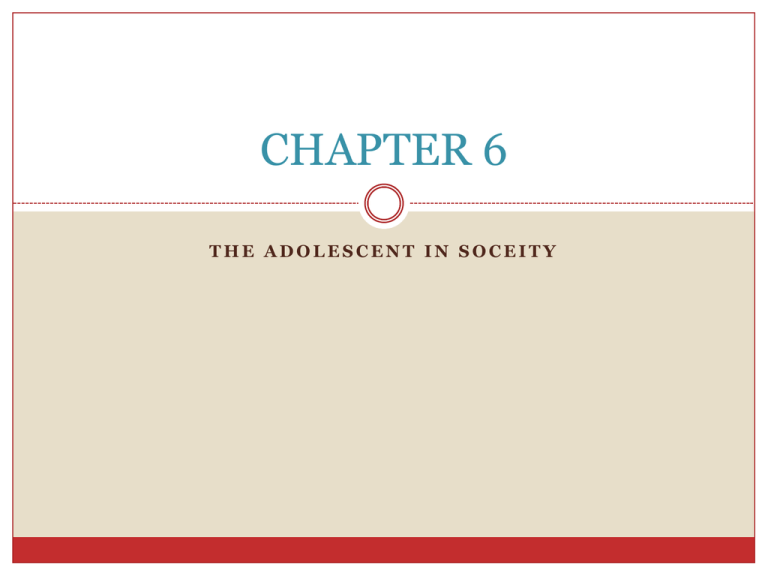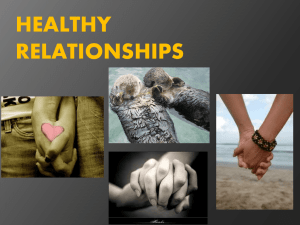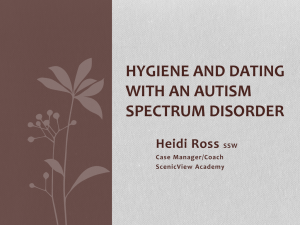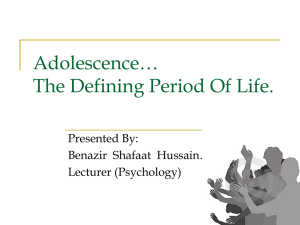
CHAPTER 6
THE ADOLESCENT IN SOCEITY
ADOLESCENCE IN OUR
SOCIETY
SECTION 1
ADOLESCENCE IN OUR SOCIETY
Caught between two worlds
No longer children
Not yet adults
Adolescence: the period between the normal onset
of puberty and the beginning of adulthood
Puberty: maturing that makes an individual
capable of sexual reproduction
ADOLESCENCE IN OUR SOCIETY
Adolescence is not a universal phenomenon
Only recognized in much of the industrial world
American society: 12-19 years old
Puberty and acceptance into the adult world occur at
different times for different people
Beginning and ending dates of adolescence are
somewhat blurred
ADOLESCENCE IN OUR SOCIETY
The concept of Adolescence
Preindustrial societies- many young people go from
childhood directly to adulthood once they have taken
part in formal ceremonies known as puberty rites
o
o
Rites take place around 13 or 14 and differ from society to
society
Include strength and endurance, filing of teeth, and tattooing
ADOLESCENCE IN OUR SOCIETY
Those who complete these rites successfully are
immediately accepted as adult members of society
Many are still in their early teens
No concept of adolescence
Adolescence is a relative new phenomenon
Didn’t exist prior to Civil War in the U.S.
Treated simply as small adults
ADOLESCENCE IN OUR SOCIETY
Acknowledge in industrialized countries in the last
century
Three factors in development of adolescence:
1)
2)
3)
Education-mandatory to go to school until 16; most stay
until 18 and then attend college; dependant on parents
until after college
Exclusion of the labor force- can not work until 16 in
most states; not full-time jobs
Juvenile-justice system-separate legal system
ADOLESCENCE IN OUR SOCIETY
Characteristics of adolescence
Adolescence not the same for everyone
Five characteristics generally apply to everyone:
1)
2)
Biological growth and development: puberty, spurts of
growth in height and weight; development of primary and
secondary sexual characteristics; acne; many have
embarrassment and anxiety during this phase
Undefined status: expectations are vague; some treated as
adults and others treated as children; some have different
attitudes: more youthful in dress and music and some are
more adult-like
ADOLESCENCE IN OUR SOCIETY
3)
4)
Increased decision making: must make many of their
own decisions; seems to be on end to the decisions that must
be made; classes, clubs, sports, college, career etc? some have
no long-term effect and some have far-reaching
consequences
Increased pressure: restricted by parents, but encouraged
to be social and active; balance between parent wishes and
peer pressure; pressures at school; pressure from each otherbe part of the “in” group; latest fads and fashion; establish
relationships; job-related pressures
ADOLESCENCE IN OUR SOCIETY
5)
The search for self: what do you want out of life?
Constantly thinking about it….many sort through their values
and decide what is really important; establish personal
norms that guide their behavior; set priorities for their lives..
Prepare for adulthood; anticipatory socialization- learning
rights, obligations, and expectations of a role to prepare for
assuming that role in the future
These characteristics are quite general
Individual experiences may vary
A persons race, religion, social and economic status,
and place of residence all play a factor in a person’s
adolescent experience
TEENAGERS AND DATING
SECTION 2
TEENAGERS AND DATING
Dating is a social behavior that is familiar to the vast
majority of Americans- particularly teenagers
Dating is not a universal phenomenon
Dating- the meeting of people as a romantic
engagement, is most commonly found in societies
that allow individuals to choose their own marriage
partners
Some societies marriages are arranged by parents or
a go-between who negotiates a formal marriage
contract between families
TEENAGERS AND DATING
Spouses may never have seen each other until the
marriage day
Dating is very widespread in America
Relatively new phenomenon in America; emerge just
after World War 1
TEENAGERS AND DATING
Courtship and Dating
Prior to dating in the U.S. interaction between men
and women was restricted to courtship
Courtship differs from dating in that courtship’s
express purpose is eventual marriage
Dating may lead to marriage
Main purpose is entertainment and amusement in the casual
stages
Dating is the means in which most individuals
eventually select their marriage mate
TEENAGERS AND DATING
Process is a continuum:
Casual dating – steady dating – engagement – marriage
As you move along the continuum, the degree of
commitment to the relationship increases
Interaction may stop at any point on the continuum
Some stages may be bypassed
Very flexible system
Courtship was not flexible: somewhere between
steady dating and engagement
Courtship was not casual, roles were very defined
TEENAGERS AND DATING
Men:
1.
First meet the women's parents
2.
Ask permission
3.
Intentions honorable, and above all, marriage minded
Conducted in the parlor of the woman’ s home under
close supervision or in a social situation among a
group of people
Rarely left alone
Marriage was expected if courtship continues over a
long period of time
TEENAGERS AND DATING
Did not have fun together, main purpose to find a
spouse
Dating emerges from this strict structure
TEENAGERS AND DATING
The Emergence of Dating
Rise of industrialization contributed greatly to the
development of dating in the U.S.
People began leaving the family farms and moving to
the cities
Young adults become less dependant on their
parents for economic security
Seeked employment away from the family farms and
started their own households
TEENAGERS AND DATING
Parental control was reduced and courtship soon
emerges into dating
Free public secondary education was another factor
Many public schools coed unlike the private schools
Post WW I- more Americans acquired telephones
and cars
Gives young people more freedom
1920’s- increased social and political equality for
women
More women enter the workforce and take active roles in the
communities
TEENAGERS AND DATING
Willard Waller:
Conducted one of the earliest sociological analyses of
American dating patterns
1)
2)
3)
4)
Study the habits of students at Penn State in lat 20’s and
early 30’s
Concluded that casual dating was a form of entertainment
that had little to do with mate selection
Status attainment and excitement were at the center of the
dating process
Partners selected on the basis of status characteristics, like,
good looks, nice clothes, and popularity
TEENAGERS AND DATING
4)
5)
6)
Found that dating was almost limited to the fraternities and
sororities
Individuals dated people of similar rank: “best” fraternities
dated “best” sororities
Object was to be seen with the “right” people
Later research challenges Waller’s “rating and
dating” game
Character and personality factors are also important
Similarities exist between casual dating partners and
marriage partners
TEENAGERS AND DATING
Homogeny- the tendency of individuals to marry
people who have social characteristics similar to
their own
TEENAGERS AND DATING
Why Date?
Dating serves several important factors:
1)
2)
3)
4)
5)
Entertainment: simply get together and have fun
Mechanism for socialization: teaches about the opposite sex
and how to behave in social situations
Fulfills basic psychological needs: conversation,
companionship, and understanding
Attain status: people value those we date
Spouse selection
TEENAGERS AND DATING
Dating Patterns
Viewed as continuum
Traditional: patterns prior to the 1960’s
Contemporary: characteristics of today's dating patterns
Traditional: found in small towns and rural areas
• Responsibility for arranging a date fell with the man
• Very ritualized-both parties knew what was expected of them
because rules of conduct were well defined
• Behavior that was not accepted met with sharp disapproval
TEENAGERS AND DATING
•
•
•
•
Accepting dates late in the week were viewed as second choices
for men
If did not have a date on intended date night, hid in your room
in shame
Early stages revolved around set activates such as the movies
or sporting events
Developed into steady dating; give the girl a class ring. Id
bracelet, or letter jacket
TEENAGERS AND DATING
Contemporary Dating: Post-1960s dating pattern
o No stages of dating
o More equality in dating; both sexes initiate dates
o Either or each partner pays for the date
o Based more on friendship and the group; no “line” needed
Challenges of Adolescence
SECTION 3
Challenges of Adolescence
Teenage Sexual Behavior
Norms governing sexual behavior vary widely from
society to society
Some preindustrial societies permit adolescents to
engage in sexual behavior before marriage
Viewed as preparation for marriage
Western countries, traditional sexual values include
strict norms against premarital sexuality
Traditional sexual values of the U.S. are an
outgrowth of Puritan and Victorian views of sexual
morality
Challenges of Adolescence
According to these views, sexual activity should be
confined to marriage
Until 1960s’ traditional sexual values had the
support of the vast majority of Americans- at least in
principle, if not always in practice
Development of birth control in the 1960s and the
1970s, youth counterculture, and the feminist
movement led to the “sexual movement”
Norms began to change
Became an open topic for discussion
Challenges of Adolescence
Sexual references are common in the programs in
seen in 98 percent of American household TV sets
Vary degrees of physical intimacy is found in all
movies except “G”
Advertisers use sex to sell their products
Led to an increase in teenage sexual behavior
Challenges of Adolescence
Rate of Teenage Sexual Activity
1970: 29% of unmarried American females between
the ages of 15 and 19 were sexually active
1995: 50% were sexually active
1970: 22 births per 1,000 unmarried teenage females
1996: 43 births per 1,000 unmarried teenage females
Numbers have dropped since the early 1990s
Challenges of Adolescence
Many young people engage in sexual risk behaviors that
can result in unintended health outcomes. For example,
among U.S. high school students surveyed in 20091
46% had ever had sexual intercourse
34% had had sexual intercourse during the previous 3
months, and, of these
39% did not use a condom the last time they had sex
77% did not use birth control pills or Depo-Provera to prevent
pregnancy the last time they had sex
14% had had sex with four or more people during their
life
Sexual risk behaviors place adolescents at risk for
HIV infection, other sexually transmitted diseases
(STDs), and unintended pregnancy:
An estimated 8,300 young people aged 13–24 years
in the 40 states reporting to CDC had HIV infection
in 2009
Nearly half of the 19 million new STDs each year are
among young people aged 15–24 years
More than 400,000 teen girls aged 15–19 years gave
birth in 2009
Challenges of Adolescence
A majority of both girls and boys who are sexually
active wish they had waited. Of those who have had
sex, more than one half of teen boys (55%) and the
majority of teen girls (70%) said they wish they had
waited longer to have sex.
Nineteen (19) million new STD infections occur each
year, almost half of them among young people ages
15 to 24.
One in two sexually active youth will contract an STD
by age 25
Challenges of Adolescence
Forty percent (40%) of older adolescents surveyed by the
Kaiser Family Foundation incorrectly believe that the
contraceptive “pill” and “shot” protect against STDs and
HIV.
Some young people, including those who had abstinence
education, consider oral and anal sex to be abstinent
behaviors and do not realize these behaviors present
risks of STD transmission
In 2004, an estimated 4,883 people ages 13-24 received a
diagnosis of HIV infection or AIDS, representing about
13% of the people given a diagnosis that year.
Challenges of Adolescence
Influences on Early Sexual Activity
1. Family-income Level: higher-income= lower rate
2. Parents’ marital status: two-parent families= lower
rate
3. Religious participation= actively practice their
religion= lower rate
Teenagers that have friends that engage in
premarital sex are more likely to be sexually active
Drug-use and delinquency are other risk factors
that lead to premarital sex
Challenges of Adolescence
Consequences of Early Sexual Activity
Most consequences for teenagers are negative
1.
2.
3.
4.
5.
6.
Babies born to teenage mothers have lower birth weights and are
more likely to die within the first year of life than are babies born to
women older than 20
Teenagers who become mothers and fathers are less likely to finish
high school and college than teenagers who do not become
parents. Particularly true for teenager mothers
Due in large part to lower levels of education, individuals who
become parents during adolescence have lower lifetime earnings
Children of teenage parents are more likely to experience learning
difficulties than children of older parents
Children of teenage parents have an increased risk of becoming
teenage parents themselves
Teenage mothers often face significant emotional stress
Challenges of Adolescence
Two main focuses: 1. health 2. social
On average about one million teenage women
become pregnant each year
Exposed to STD’s such as syphilis, gonorrhea,
Chlamydia, and HIV/AIDS
4 million teens acquire an STD each year
Challenges of Adolescence
Teenage Drug Use
Drug-any substance that changes mood, behavior, or
consciousness
Exists in many forms: medicine, alcohol, cigarettes,
marijuana, cocaine and heroin
Long historya)
b)
c)
Greeks smoked opium 3,000 years ago
Aztecs used hallucinogens
United States- heroin and cocaine were
used for non medical purposes until early 1900s
Challenges of Adolescence
Drug Violence
Public has become very concerned over the rise in
violence related to drugs
Saw its height in the mid-1980s through the 1990s
Violence is a result of turf-wars of drug trafficking
Criminal gangs control the drug trade in the U.S.
Crack cocaine is believed to have been the principal
cause of the dramatic rise in drug-related violence
With its introduction in the mid 1980s, drug-related
juvenile arrests skyrocketed
Challenges of Adolescence
Rate of Teenage Drug Use
Marijuana usage has declined over the years, but still
remains the most used drug among high school
students
Cocaine has followed a similar pattern
LSD peaked in the mid 1990’s
MDMA OR ecstasy increased in the 1990s and into
the 2000s
Cigarette smoking has dropped very slightly (19% of
all high school seniors smoke daily)
Challenges of Adolescence
Alcohol has declined over the years but still remains
a widespread problem
73% of high school seniors surveyed admitted to
have used alcohol
United States has the highest rate of drug use among
adolescents in the industrialized world
Challenges of Adolescence
Influences on Teenage Drug Use
Why do teenagers use drugs?
Chief Factors:
1.
2.
3.
Having friends that regularly use drugs
Having social and academic adjustment problems
Living in a hostile and rejecting family setting
Challenges of Adolescence
1. Factors that appear to effect teenage suicide:
a)
b)
c)
d)
e)
f)
g)
Alcohol and drug use: users of high levels of alcohol and drugs have
a low levels of self control; more likely to act on impulse; method of
suicide
Triggering events: specific event or anticipation of event; fear of
punishment, loss or rejection, unwanted pregnancy, family crisis,
poor school performance, or fight with family or friend
Age: older teenagers and young adults
Sex: females 3 times more likely; males much more likely to
succeed- use weapons
Population density: under populated areas have higher rates; social
isolation, access to fewer services
Family relations: weakening of social bonds; families of violence,
intense marital conflict, or the recent loss of a parent through death
or divorce; hostility or rejection towards children
Cluster effect
Challenges of Adolescence
a)
b)
c)
Population density: under popualted areas have higher rates;
social isolation, access to fewer services
Family relations: weakening of social bonds; families of
violence, intense marital conflict, or the recent loss of a
parent through death or divorce; hostility or rejection
towards children
Cluster effect: result in other attempts in a community;
trigger a “copycat”





